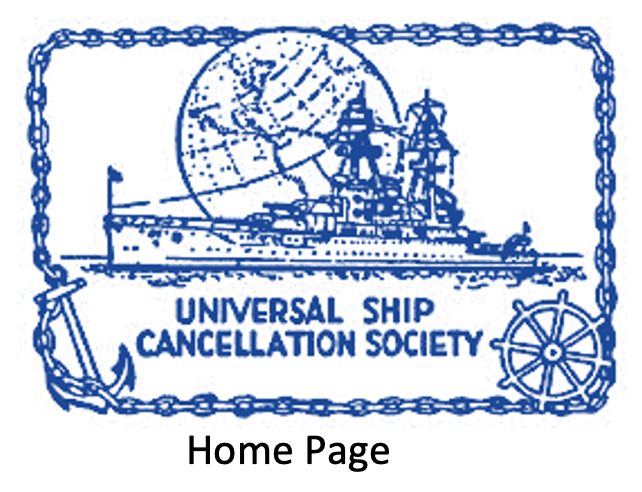Exhibit by Steve Shay (USCS 10,821)
This exhibit was first displayed at the 2001 Universal Ship Cancellation Society annual convention. This was Steve’s first exhibit and it received the following awards:
Gold Medal, Multi-frame Competition
Reserve Grand Award
Novice Award
Outstanding job, Steve!!
Synopsis
Forty-four submarines were built at the Mare Island Ship Yard between the years of 1930 and 1970. The first submarine was the USS V-6, later to be renamed USS Nautilus.
The V-6 commissioning cover in Frame 1 has very likely the first cachet to be applied to a Mare Island event. The postmark used on this cover was given to the ship by Roy Sherman and the North Bay Stamp Club in Vallejo. The Provisional cancel for V-6 is rare. (Postmark catalog rating R-2.) The Type 5 Nautilus postmark is a very early example, possibly the earliest known usage, after the V-6 was renamed Nautilus in 1931 and the V-6 postmark was no longer used.
Martin Aden, a Mare Island employee, designed a number of cachets used for keel laying, launchings, commissioning and other special events. Many of the cachets in Frame 1 and 2 are Aden designs. His style is recognizable by fine detail.
Covers for Mare Island commissioning during the war are rare. The Wahoo launch cover is a highly prized cover. This sub developed highly successful tactics which were later used on other subs. A late Tunny cover features a cachet when Tunny was one of handful of subs capable of surfacing and firing a nuclear missile; this before the Polaris missile was in use. The post card on the Tinosa page features a pre-war post card of the Kamo Maru, a ship sunk by Tinosa.
Beginning in Frame 2, the covers for the 1943 and 1944 commissioning shown are from an unknown cachet artist, possibly Harvey Brown. These are rare cachets. The cover from a sailor on Skate was postmarked upon return from her second war patrol during which she damaged the battleship Yamato.
Mare Island contributed a lot to the war effort
In the Pacific; nine of the top 25 scoring subs during World War II were built at Mare Island and seven of the 52 subs lost during the war were built at the yard.
The Stickleback covers show rare mail to a submarine during the 1950’s. These were obtained from a crewman.
After the war, Mare Island continued to build submarines. The Grayback (Frame 2) was the first Mare Island designed sub and the first sub designed to carry missiles. Lloyd Piller, the cachet artist for the launch cover was the son in law of Martin Aden. The Sargo would be the first nuclear submarine built at Mare Island.
In Frame 3, the Halibut would be the first Mare Island nuclear design, once again designed to carry missiles. Halibut would be followed by seven ballistic missile submarines and eight attack subs.
Covers for launching and commissioning of the submarines built after the war were often sponsored by the Mare Island Supervisors Association, later known as the National Association of Supervisors. Many of these cachets were designed by Ray Costa though drawn by others. The USS Saginaw Chapter of the USCS, first formed in 1965, also sponsored covers for ship events beginning with the Mariano G. Vallejo.
The Hawkbill, decommissioned in 2000 was one of the last subs built for surfacing through the Arctic ice. The Kamehameha is the only active Mare Island submarine as of Summer 2001.
The Drum commissioning cover in Frame 3 is one of 2 copies with all wardroom officer’s signatures. Drum would be the 513th and last ship built at Mare Island.
Title Page
The first naval shipyard on the West Coast was established September 16, 1854 at Mare Island, California. Located in the San Francisco Bay Area, the first commander was Commander David Farragut. The yard operated continuously until March 31, 1996 when Defense budgeting closed the shipyard as part of the base conversion process. Over 500 ships were built at the yard during the 142 years of operation. 44 of these ships were submarines. These submarines made an important contribution to the war effort in the Pacific during World War II and made technology advances in the evolution of submarine design.
The purpose of this exhibit is to document the 44 submarines built at the Mare Island Naval Shipyard.
The material that is presented includes philatelic keel laying, launch and commissioning covers as well as non-philatelic mail to and from the submarines. Not every submarine had an on board post office or had a reported postmark. Those without postmarks are noted.
Exhibit Highlights:
Frame 1:
First Mare Island cachet, V-6 Commissioning
Rare Provisional V-6 cancel
Hand tinted Martin Aden cachets (Sturgeon and Swordfish)
Frame 2:
Rare Mare Island commissioning cachets during war years (Seahorse, Skate, Tang, Tilefish, Spadefish, Trepang, Spot, Springer)
Non-philatelic mail from Skate
Non-philatelic mail addressed to Stickleback
Frame 3:
Drum commissioning cover with officer’s signatures.
